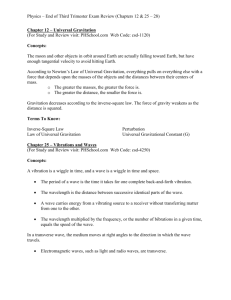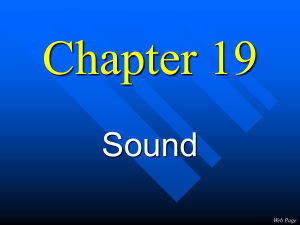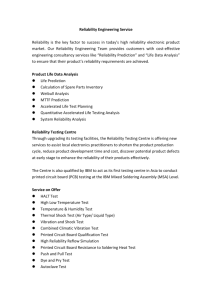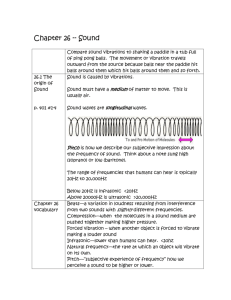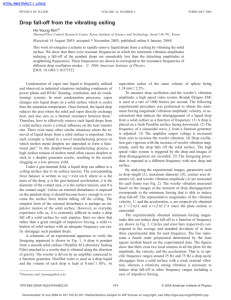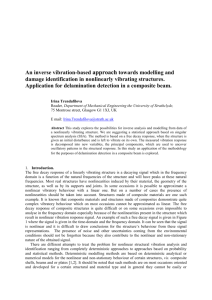Chapter 26 Summary Sound is a form of energy that spreads out
advertisement
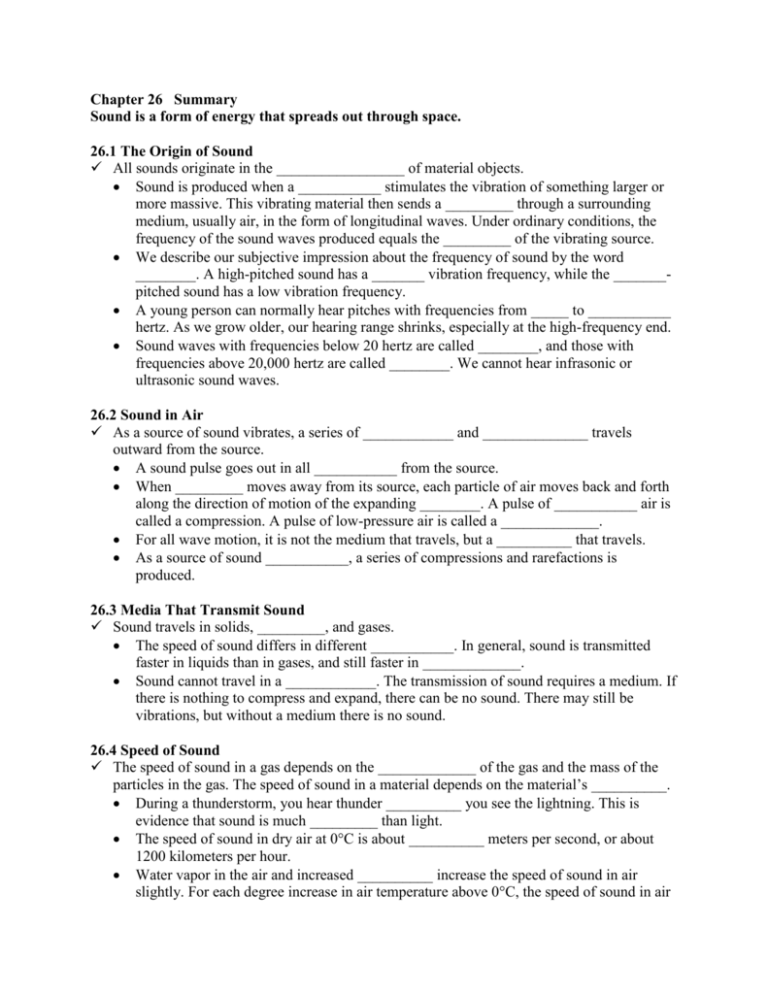
Chapter 26 Summary Sound is a form of energy that spreads out through space. 26.1 The Origin of Sound All sounds originate in the _________________ of material objects. Sound is produced when a ___________ stimulates the vibration of something larger or more massive. This vibrating material then sends a _________ through a surrounding medium, usually air, in the form of longitudinal waves. Under ordinary conditions, the frequency of the sound waves produced equals the _________ of the vibrating source. We describe our subjective impression about the frequency of sound by the word ________. A high-pitched sound has a _______ vibration frequency, while the _______pitched sound has a low vibration frequency. A young person can normally hear pitches with frequencies from _____ to ___________ hertz. As we grow older, our hearing range shrinks, especially at the high-frequency end. Sound waves with frequencies below 20 hertz are called ________, and those with frequencies above 20,000 hertz are called ________. We cannot hear infrasonic or ultrasonic sound waves. 26.2 Sound in Air As a source of sound vibrates, a series of ____________ and ______________ travels outward from the source. A sound pulse goes out in all ___________ from the source. When _________ moves away from its source, each particle of air moves back and forth along the direction of motion of the expanding ________. A pulse of ___________ air is called a compression. A pulse of low-pressure air is called a _____________. For all wave motion, it is not the medium that travels, but a __________ that travels. As a source of sound ___________, a series of compressions and rarefactions is produced. 26.3 Media That Transmit Sound Sound travels in solids, _________, and gases. The speed of sound differs in different ___________. In general, sound is transmitted faster in liquids than in gases, and still faster in _____________. Sound cannot travel in a ____________. The transmission of sound requires a medium. If there is nothing to compress and expand, there can be no sound. There may still be vibrations, but without a medium there is no sound. 26.4 Speed of Sound The speed of sound in a gas depends on the _____________ of the gas and the mass of the particles in the gas. The speed of sound in a material depends on the material’s __________. During a thunderstorm, you hear thunder __________ you see the lightning. This is evidence that sound is much _________ than light. The speed of sound in dry air at 0°C is about __________ meters per second, or about 1200 kilometers per hour. Water vapor in the air and increased __________ increase the speed of sound in air slightly. For each degree increase in air temperature above 0°C, the speed of sound in air increases by about 0.60 m/s. In air at a normal room temperature of about 20°C, sound travels at about _______ m/s. The speed of sound in a gas also depends on the mass of its particles. Lighter gas particles move ______ and transmit sound much more quickly than heavier gas particles. The speed of sound in a ________ material depends not on the material’s density, but on its elasticity. Elasticity is the ability of a material to change shape in response to an applied force, and then resume its initial shape once the distorting force is removed. Steel is very ________; putty is inelastic. 26.5 Loudness Sound intensity is objective and is measured by instruments. ___________, on the other hand, is a physiological sensation sensed in the brain. The intensity of a sound is proportional to the square of the amplitude of a sound wave. The unit of intensity for sound is the ___________ (dB). Starting with zero at the threshold of hearing for a normal ear, an increase of each 10 dB means that sound intensity increases by a factor of 10. A sound of 10 dB is 10 times as intense as sound of 0 dB. Likewise, 20 dB is not twice but 10 times as intense as 10 dB, or 100 times as intense as the threshold of hearing. Physiological hearing damage begins at exposure to _________ decibels. The extent of damage depends on the length of exposure and on frequency characteristics. 26.6 Natural Frequency When any object composed of an elastic material is disturbed, it ________ at its own special set of frequencies, which together form its special sound. An object’s ________ frequency is the frequency at which the object vibrates when it is disturbed. Natural frequency depends on the ___________ and shape of the object. Most things—from planets to atoms and almost everything else in between—have a springiness to them and vibrate at one or more natural frequencies. A natural frequency is one at which ____________ energy is required to produce forced vibrations. It is also the frequency that requires the least amount of __________ to continue this vibration. 26.7 Forced Vibration Sounding boards are an important part of all stringed __________ instruments because they are forced into vibration and produce the __________. A ________ vibration occurs when an object is made to vibrate by another vibrating object that is nearby. The ____________ of guitar strings in an acoustical guitar would be faint if they weren’t transmitted to the guitar’s __________ body. The mechanism in a music box is mounted on a sounding board. Without the _________ board, the sound would be barely audible. 26.8 Resonance An object ___________ when there is a force to pull it back to its starting position and enough energy to keep it vibrating. Resonance occurs when the _____________ of a vibration forced on an object matches the object’s natural ____________, causing a dramatic increase in _____________. A common experience illustrating ______________ occurs on a swing. Even small pumps or pushes, if delivered in rhythm with the natural frequency of the swinging motion, produce large _________________. When you tune a radio set, you are adjusting the natural ____________ of the electronics in the set to __________ one of the many incoming signals. The set then resonates to one station at a time, instead of playing all the stations at once. 26.9 Interference When constructive interference occurs with sound waves, the listener hears a __________ sound. When destructive interference occurs, the listener hears a ________ sound or no sound at all. The crest of a transverse wave corresponds to a __________ of a sound wave, and the trough of a transverse wave corresponds to a rarefaction of a sound wave. When the crests of one wave overlap the __________ of another wave, there is constructive interference and an increase in amplitude. When the crests of one wave overlap the troughs of another wave, there is __________ interference and a decrease in amplitude. ___________ sound interference is a useful property in anti-noise technology. 26.10 Beats When two tones of __________ different frequency are sounded together, a regular fluctuation in the ___________ of the combined sounds is heard. The periodic variation in the loudness of sound is called ___________. Beats can be heard when two slightly mismatched tuning forks are __________ together. When the combined waves reach your ears in step, the sound is a maximum. When the forks are out of step, in the sound is a minimum. Beats can occur with any kind of _________ and are a practical way to compare frequencies. When wave frequencies are identical, beats _____________.

